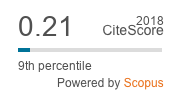Average Variance Extracted and Composite Reliability:
Reliability Coefficients
Keywords:
Average variance extracted, Composite reliability, Validity, Reliability, Confirmatory factor analysisAbstract
The average variance extracted (AVE) and the composite reliability coefficients (CR) are related to the quality
of a measure. Meanwhile, in order to avoid misconceptions, it is required to properly comprehend the equations of the AVE and CR, as well as their relation with the definition of validity and reliability. In this paper, we illustrate, using simulated onefactor models, how the number of items and the homogeneity of factor loadings might influence the AVE and CR results. In so doing, we show that the use of fixed AVE and CR cutoffs is problematic. Moreover, we present reasons endorsing the use of the AVE as a reliability coefficient, instead of a convergent validity index.
Downloads
References
American Educational Research Association, American
Psychological Association, National Council on Measurement in
Education. (1966). Standards for educational and psychological
testing. Washington, DC: American Psychological Association.
American Educational Research Association, American
Psychological Association, National Council on Measurement in
Education. (1999). Standards for educational and psychological
testing. Washington, DC: American Psychological Association.
American Educational Research Association, American
Psychological Association, National Council on Measurement in
Education. (2014). Standards for educational and psychological
testing. Washington, DC: American Psychological Association.
Bagozzi, R. P., & Yi, Y. (1988). On the evaluation of structural
equation models. Journal of the Academy of Marketing Science,
(1), 74”“94. doi:10.1007/BF02723327
Campbell, D. T., & Fiske, D. W. (1959). Convergent and
discriminant validation by the multitrait-multimethod matrix.
Psychological Bulletin, 56(2), 81”“105. doi:10.1037/h0046016
Cronbach, L. J. (1951). Coefficient alpha and the internal structure
of tests. Psychometrika, 16(3), 297”“334. doi:10.1007/
BF02310555
Cronbach, L. J., & Meehl, P. E. (1955). Construct validity in
psychological tests. Psychological Bulletin, 52(4), 281”“302.
doi:10.1037/h0040957
Farrell, A. M. (2010). Insufficient discriminant validity: A comment
on Bove, Pervan, Beatty, and Shiu (2009). Journal of Business
Research, 63(3), 324-327. doi:10.1016/j.jbusres.2009.05.003
Ferguson, G. A. (1981). Statistical Analysis in Psychology and
Education. New York, NY: McGraww-Hill
Fock, H., Hui, M. K., Au, K., & Bond, M. H. (2013). Moderation
effects of power distance on the relationship between
types of empowerment and employee satisfaction.
Journal of Cross-Cultural Psychology, 44(2), 281”“298.
doi:10.1177/0022022112443415
Fornell, C., & Larcker, D. F. (1981). Evaluating structural equations
models with unobservable variables and measurement error.
Journal of Marketing, 18(1), 39-50. doi:10.2307/3151312
Geisenger, K. F. (1992). The metamorphosis of test validation.
Educational Psychologist, 27(2), 197-222. doi: 10.1207/
s15326985ep2702_5
Guilford, J. P. (1954). Psychometric Methods. New York, NY:
McGraw-Hill
Hair, J. F., Black, W. C., Babin, B. J., Anderson, R. E., & Tatham, R.
L. (2009). Análise multivariada de dados (6th. ed.). Bookman:
Porto Alegre.
Han, K. T. (2007). WinGen: Windows software that generates
IRT parameters and item responses. Applied Psychological
Measurement, 31(5), 457-459. doi:10.1177/0146621607299271
Han, K. T., & Hambleton, R. K. (2007). User’s Manual: WinGen
(Center for Educational Assessment Report No. 642). Amherst,
MA: University of Massachusetts, School of Education.
Messick, S. (1980). Test validity and the ethics of assessment.
American Psychologist, 35(11), 1012”“1027. doi:10.1037/0003-
X.35.11.1012
Messick, S. (1989). Validity. In R. L. Linn (Ed.), Educational
Measurement (3rd ed., pp. 13-103). New York: American
Council on Education/Macmillan.
Niclasen, J., Skovgaard, A. M., Andersen, A.-M. N., Sømhovd,
M. J., & Obel, C. (2013). A confirmatory approach to
examining the factor structure of the Strengths and Difficulties
Questionnaire (SDQ): A large scale cohort study. Journal
of Abnormal Child Psychology, 41(3), 355”“365. http://doi.
org/10.1007/s10802-012-9683-y
Nunnally, J. C., & Bernstein, I. H. (1994). Psychometric Theory
(3rd. ed.). New York: McGraw-Hill.
Obasi, C. N., Brown, R. L., & Barrett, B. P. (2014). Item reduction
of the Wisconsin Upper Respiratory Symptom Survey
(WURSS-21) leads to the WURSS-11. Quality of Life
Research, 23(4), 1293”“1298. http://doi.org/10.1007/s11136-
-0561-z
Peterson, R. A., & Kim, Y. (2013). On the relationship between
coefficient alpha and composite reliability. Journal of Applied
Psychology, 98(1), 194”“198. doi:10.1037/a0030767
Primi, R. (2012). Psicometria: Fundamentos matemáticos da
Teoria Clássica dos Testes. Avaliação Psicológica, 11(2),
-307. Retirado de: http://pepsic.bvsalud.org/pdf/avp/v11n2/
v11n2a15.pdf
Raykov, T. (2001). Bias of coefficient for fixed congeneric measures
with correlated errors. Applied Psychological Measurement,
(1), 69”“76. doi:10.1177/01466216010251005
Raykov, T. (2003). Scale reliability evaluation with LISREL 8.50.
Retrieved from www.ssicentral.com/lisrel/techdocs/reliabil.pdf
Rios, J., & Wells, C. (2014). Validity evidence based on
internal structure. Psicothema, 26(1), 108-116. doi:10.7334/
psicothema2013.260
Sijtsma, K. (2009). On the use, the misuse, and the very limited
usefulness of Cronbach”s alpha. Psychometrika, 74(1), 107-
doi:10.1007/s11336-008-9101-0
Sireci, S. G. (2007). On validity and test validation. Educational
Researcher, 36(8), 477-481. doi:10.3102/0013189X07311609
Thompson, B. (2002). Score reliability: Contemporary thinking
on reliability issues. Thousand Oaks, CA: Sage publications.
Urbina, S. (2007). Fundamentos da testagem psicológica. Porto
Alegre: Artmed.
Wildaman, K. F. (1985). Hierarchically nested covariance structure
models for multitrait-multimethod data. Applied Psychological
Measurement, 9(1), 1-26. doi:10.1177/014662168500900101



